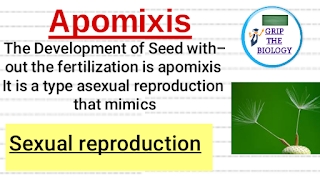Apomixis in Flowering plant -- An overview
Apomixis in Flowering plant -- An overview
- The phenomenon of asexual reproduction that mimics the sexual reproduction and produce seed without the fertilisation is termed apomixis or agamospory.
- During apomixis, a diploid egg is formed without the reduction division which develops into an embryo without the process of fertilization.
- Some cells of nucellus which are diploid in nature, start dividing and develop into embryos without fertilisation.For example - citrus fruit, Mango.
- Seed is the final product of fertilisation in flowering plants but in some plants like grasses and members of the family Asteraceae have special mechanisms. They produced seeds without fertilization.
- The substitution of sexual process by asexual methods is called apomixis and the plant those exhibit this phenomenon called apomictic plant.
- Winkler described apomixis that " the substitution of sexual method which does not involve syngamy and meiosis "
Types of apomixis
- In non recurrent apomixis, the megaspore mother cell divides through meiosis as a normal process and produces four megaspore.
- Out of four , one megaspore develops into an embryo sac.
- In non recurrent apomixis, there is no fertilization so embryos are formed from either unfertilised egg or from some other cell of the embryo sac . The embryo that is formed by this process is haploid in nature.
- The development of embryo from unfertilised egg and from some other cell of embryo sac without the fertilisation is called Haploid parthenogenesis and haploid apogamy respectively.
- The formation of haploid embryos through Haploid parthenogenesis is important in terms of genetics because it produces true breeding homozygous plants.
- Jorgensen observed haploid parthenogenesis in species of Solanum.
- Hagerup observed haploid parthenogenesis in plants like Orchid, Epipactis, Cephalanthera. Haploid apogamy is seen in plants like Lilium, Bergenia etc.
- In recurrent apomixis, the embryo sacs are developed from either a cell of archesporium or some other cell of nucellus. It is called generative apospory and somatic apospory respectively.
- Example of generative apospory and somatic apospory is Parthenium and Hirecium respectively.
- In adventive embryony, embryo is developed from any diploid cell of ovule located outside the embryo sac like nucellus and integuments. The embryo that is formed from adventive embryony does not have suspensor.
- Apomixis is beneficial to get a desirable character because there is no source of change in apomixis. The reason is that there is no meiosis, no segregation of chromosomes and there is no recombination of chromosomes.

Comments
Post a Comment